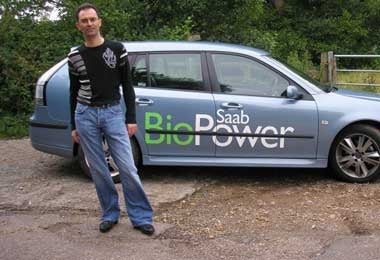The Verdict: Saab 9-3 Biopower Vector Sport Estate
Saab's bioethanol flagship is full of useful and unusual detail, but needs a stronger nudge from the Chancellor to take off, says David Wilkins

Specifications
Price: £24,895
Engine: 1.8-litre E85/petrol
P erformance*: 0-60 mph in 8.2 seconds, 35.8 mpg *running on unleaded
CO2: 189g/km
Worth considering: Saab 9-3 diesel estate, Saab 9-5 BioPower estate, Volvo V50 Flexifuel estate
A few months ago I set off in a new model from one of the budget brands and immediately discovered an intriguing feature. I indicated left and the associated ticking noise came from somewhere far over on the left-hand side of the dashboard. I was impressed. Directional indicator ticking – not even Mercedes had thought of that one. I was less impressed when I indicated right and the ticking again came from the far left side. Still, this was only a minor annoyance to which one soon adjusted.
Anyway, the Saab 9-3 BioPower estate has an up-market version of the same characteristic; in this case, it's the voice prompts of the optional sat-nav system that emanate from the left-hand side of the car's interior. Somehow, this made it seem much more like these instructions were being issued by a real person, rather than a piece of electronic circuitry – a front-seat passenger, perhaps, or a posh, bossy female stowaway hiding in the glovebox.
I found this mildly pleasing, especially on long solo trips. But if you see your car as a refuge from that sort of nagging, the mobile equivalent, perhaps, of the potting shed or the allotment, then the 9-3's factory-fit sat-nav may not be for you.
Other quirks? Well, there's Saab's famous floor-mounted ignition key and the "nightpanel" button, which blacks out the dash lighting except for a few essentials such as the active area of the speedometer – and an infuriating handbrake knob set into the underside of the lever. It's worth putting in a special mention for the seats, though, which, typically for Saab, are outstanding.
Anything new? Well the estate bodywork is now a year or two old, but that still counts as novel by Saab's standards; after all, this is a company that's only used about half a dozen different basic body shells in its entire 60-year history. The frosty rear lights, which look like big blocks of Swedish ice, are particularly appealing. Pricing – £25,000 plus more for options on our test car – is a bit steep, however.
And this car's a BioPower. We've rehearsed the pros and cons here before; it can run on bioethanol-based E85, a largely renewable fuel that delivers more go but fewer mpg than unleaded. E85 is cheaper but not by enough to offset that consumption penalty, although there are a few more Morrisons supermarkets selling it than there were last year. But progress is slow.
We're still waiting for the Chancellor to give E85 a bigger fiscal boost before it – and Saab's 9-3 BioPower – can really take off.
Ian Milton, 45, machine operator, Malmesbury, Wiltshire
Usual Car: Renault Clio 1.4
The first thing you notice about the 9.3 BioPower is how smooth and responsive the engine is when accelerating. Once you are on the motorway, you could cruise for miles, especially with the comfortable, adjustable seats and the quiet cabin. The model I drove was well equipped with sat- nav, leather seats, efficient air con, and an instrument panel that was easy to read. It was narrower than I expected, but there was space for two adults in the back, and the boot was spacious. Two criticisms: the awkward position of the handbrake release button; and the gear change. I found that changing from first to second, and vice versa, wasn't as precise as I would like.
Robin Hutt, 68, retired Methodist minister, Bridgwater
Usual car: Audi A3 Sportback
Without the foot-high letters along the side, you would never know you were driving a bio-powered vehicle. The engine is smooth and eager. Its high gearing makes for easy motorway cruising, but with enough torque for overtaking. The downside, if such it is, is that you can't use fifth gear in town, but the car corners surefootedly, so to speak, with no roll. Controls and switchgear come easily to hand, once you've got used to the Saabish quirks of a starter key between the front seats, and an odd handbrake arrangement. Once the economics and logistics of production are sorted out, the coming of biofuelled cars, on this experience, can only be a good thing.
Samir Tadros, 43, logistics coordinator, Taunton
Usual cars: Nissan Skyline, Mitsubishi Galant
Well, the name is a mouthful and the logo on the side shouts its "green" aspirations, but with only 15 sites in the UK selling biofuel, most buyers will have to make do with normal fuel, so won't get the claimed advantages of biofuel. On the plus side, as a car it is well specced and a relaxing drive on B roads and the motorway, with a capacious boot. In my test, the car was running on biofuel and certainly felt eager when pushed on an empty road. The alleged 15 per cent power hike with biofuel will certainly have boy-racers going "green" with envy. However, at this price, it can only be a niche vehicle for those wanting to flaunt their eco credentials.
The Verdict
If you would like to take part, email motoring@independent.co.uk or write to: The Verdict, Features Department, Independent House, 191 Marsh Wall, London E14 9RS, giving your address, phone number and details of the car, if any, you drive. For most cars, participants must be over 26 and have a clean licence.
Subscribe to Independent Premium to bookmark this article
Want to bookmark your favourite articles and stories to read or reference later? Start your Independent Premium subscription today.

Join our commenting forum
Join thought-provoking conversations, follow other Independent readers and see their replies